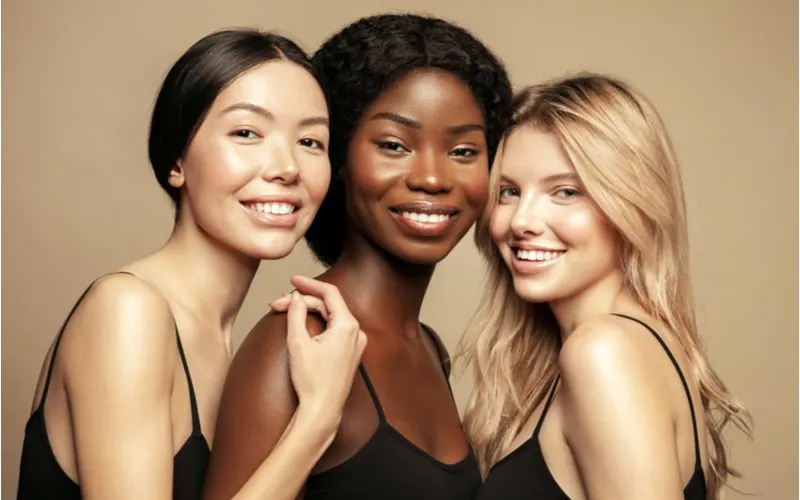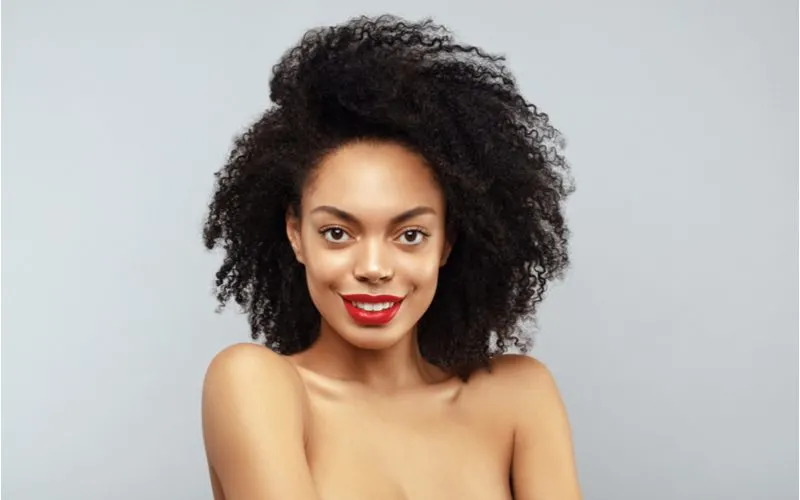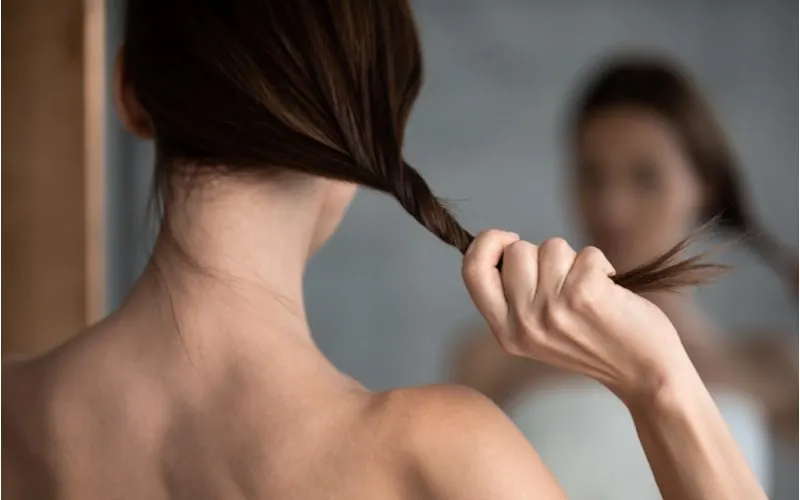Jump to:
Our “is my hair thick or thin” quiz can measure how thick or thin your hair is with just 5 questions! Find out how dense your hair is and if it’s thick or thin. Get instant results plus tips to care for your mane!
Thick and Thin: Why Hair Density Matters

Beauty Agent Studio/Shutterstock
Ever heard the phrase “I know it when I see it”? You’d think it’s easy enough to determine if your hair is thick or thin just by…well, looking at it. But looks can be deceiving. It’s not always easy to tell if you have thick, thin, or average hair density.
Hair density measures the number of hairs per square inch of your scalp. Dense (what we call ‘thick’) hair has more hairs per square inch than average. Sparse or ‘thin’ hair has fewer hairs per square inch of scalp.
Hair density is different from hair texture (fine, medium, or coarse). You can have fine, thick (dense) hair or coarse, thin (sparse) hair. And it can get even more complicated than that.
Sometimes hair that appears really thick and dense turns out to be coarse with thicker individual hairs, but fewer actual hairs on the head. Other times, hair that looks “thin” is actually densely packed with slender, baby-fine strands.
But does it really matter if your hair is thick, thin, or somewhere in between? It definitely does.
The overall “thickness” – density – of your hair dictates how you should style, cut, and care for it. If you’ve been wondering why certain cuts and styles that look great on others just don’t work for you, your hair density could be the culprit.
Take our quiz to find out if your hair is thick, thin, or medium-density! It’s 5 quick questions and you just might have the Aha! hair moment you’ve been waiting for.
Is My Hair Thick or Thin? Quiz
Not quite sure if your hair qualifies as thick, thin, or average? Take a minute to answer 5 quick questions about your hair below to find out. Our quiz will show you if you have thick, average, or thin hair, plus care and styling tips for your hair density.
You’ll get to know your mane a little better and learn how to make the most of your hair’s density level with minimal products!
You Took the Quiz. Now What?
You’ve got your results – your hair is either thick (dense), medium (average), or thin (sparse). Now that you know your mane a little better, take a minute to learn a few tips and tricks that make it easier to manage and style your hair!
Tips for Thick Hair

Beauty Agent Studio/Shutterstock
Thick hair is often envied for its glorious fullness, but it’s not always easy to wrangle thick, unruly hair. You’ll have an easier time of it if you take our advice! Since you have more strands per square inch than the average person, there’s a lot more hair to deal with. But we say double the trouble, double the fun!
- Get some XL elastics already. You’ve got to be sick of snapping one every few days by now! Grab some XL hair elastics that perfectly accommodate your thick mane. It makes your ponytail a lot more comfortable to wear, too!
- Air dry whenever possible. We know – air drying takes forever because you have so much hair. But blow drying ulta-thick strands means your hair is in contact with the dryer heat for a lot longer. If you must blow dry, use a heat protectant first.
- Rock more half-up styles. Wearing your hair up can be uncomfortably heavy. The extra weight can put a lot of tension on your scalp, which leads to hair loss over time. Rock more half-up styles or wear it down and loose when you can. It’ll be more comfortable and protect against hair loss over time!
Tips for Medium Hair

Roman Samborskyi/Shutterstock
Medium hair density gets the Best All Around superlative at hair density high. Since your hair isn’t super densely packed on your scalp, you don’t deal with the heaviness and overheating that thick-haired people do.
With the average number of strands per square inch of scalp (around 2,200), you have enough hair to appear relatively thick but not enough to sustain long periods of shedding/hair fall. Here’s what you should know about keeping medium density hair at its maximum fullness and health!
- Avoid common sources of breakage. Brushing while hair is wet, using high heat settings on hot tools, repeated chemical processing, using a fine-toothed comb, sleeping on a cotton pillowcase, ripping through tangles, wearing wool hats…there are tons of ways we cause breakage every day. To keep your fullness and avoid thinning, avoid as many sources of damage as you can.
- Eat a varied, nutritious diet. Filling your diet with healthy, nutritional foods is key to keeping your body well-stocked in the vitamins and nutrients needed to grow hair and avoid thinning. Veggies and fruits not your jam? Make sure you’re taking a hair growth supplement to get the vitamins and nutrients your body needs to grow and maintain your hair.
- Strengthen hair with protein. Protein smooths and strengthens hair from the inside out. Medium-density hair can benefit from upping your protein intake, using protein-enriched hair products, and using a protein hair mask once a week. Mixing up your own protein mask is fun, but you need hydrolyzed protein to actually penetrate and strengthen your hair.
Tips for Thin Hair

fizkes/Shutterstock
Thin hair looks best when it’s allowed to take its natural shape, whether that’s pin-straight, wavy, curly, or coily.
Bonus points if you can achieve a little boost in volume at the roots – lift at the roots creates the illusion of fuller, thicker hair with more scalp coverage. Products and supplements can get you there, but so can these tips.
- Shampoo less often. Most hair shedding occurs when we shampoo, so it makes sense to cut down on how often you wash to prevent excessive shedding. If you’ve been washing daily or every other day, drop down to 2-3 washes per week. You may find that your mane looks thicker without as many washes, but washing less often also boosts natural moisture, balances scalp pH, and preserves color longer.
- Swap out your hair brush. Chances are, you didn’t put much thought into the hair brush you’re currently using. Swap it out for one that’s proven to be gentler on hair, reduce breakage, and help distribute your natural oils for more root lift and less flatness. Nothing’s better than an authentic boar bristle brush for thin hair – grab one of the best and see the difference.
- Give your hair some extra TLC. A once-weekly strengthening hair mask, an extra dose of lightweight moisture here and there, gentle handling, and sleeping in a silk bonnet or on a silk pillowcase are all ways to give thin hair a little extra TLC. With thin hair, an ounce of prevention is worth a pound of cure. Be extra gentle and nourish your hair to avoid breakage and keep your fullness.
Did You Like Our “Is Your Hair Thick or Thin Quiz?”
You took the quiz, learned about your hair density level, and know what direction to take things from here. Mind if we take a minute to sum it all up?
Your hair density level – thick, medium, or thin – is how much hair you have on your head. It’s not about how thick or thin your individual strands are (that’s hair texture). It’s about the number of hairs you have per square inch of your scalp.
The more hair you have per square inch, the denser (thicker) your hair is. The less hair you have per square inch, the more sparse (thin) your hair is. If you’re somewhere between dense and sparse – AKA thick and thin – your hair is considered medium-density.
Thick-haired ladies, make sure you’re rocking a haircut with long layers to make your mane more manageable. Anti-frizz serum and smoothing masks are a must!
Women with medium-density strands should focus on root and overall volume, lightweight moisture, and avoiding common sources of breakage. Leave-in conditioner and strengthening protein-enriched hair products are ideal for your hair density.
Thin-haired women will see a huge difference in fullness by taking a hair growth supplement like Folexin, and temporary volume-boosting products and techniques are helpful for an instant transformation. Steer clear of heavy creams, gels, and oils and get a flattering one-length haircut to maximize your hair’s fullness.
Thick, thin, or somewhere in between, everyone’s mane has one thing in common: It’s the only hair you’ve got! Learn to love your locks as they are. The grass is greener where you water it!
